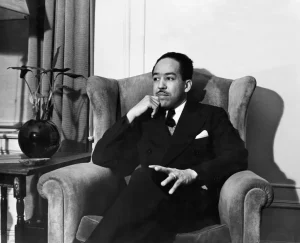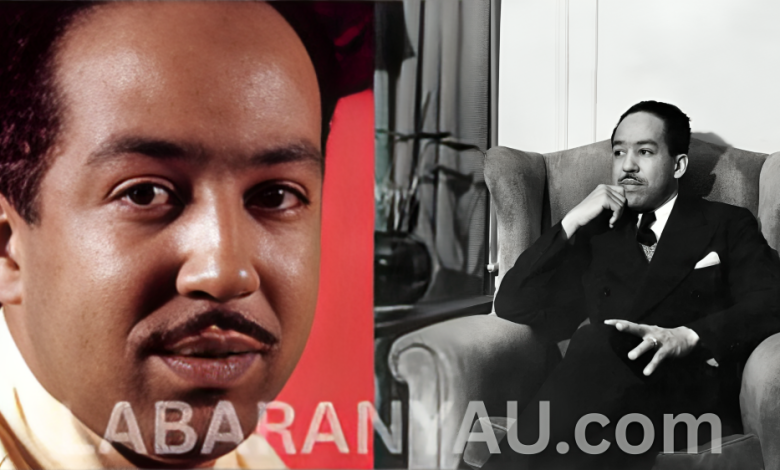
Langston Hughes Biography
Langston Hughes (February 1, 1902 – May 22, 1967) was a pioneering African-American poet, novelist, playwright, and key figure of the Harlem Renaissance, celebrated for his powerful portrayals of Black life, culture, and identity.
Born on February 1, 1902, in Joplin, Missouri, Hughes became a leading voice for African Americans, capturing their lives, struggles, and cultural richness in his work.
He gained early acclaim with his poem The Negro Speaks of Rivers in 1921 and published his first poetry collection, The Weary Blues, in 1926, blending jazz rhythms with powerful imagery.
His only novel, Not Without Laughter, was published in 1930, and he introduced the humorous and insightful character Jesse B. Semple (“Simple”) in his columns.
Hughes graduated from Lincoln University in 1929 and continued to influence generations with works like Montage of a Dream Deferred in 1951.
He died on May 22, 1967, in New York City, leaving behind a lasting literary legacy as a voice of dignity, pride, and resilience for Black America.
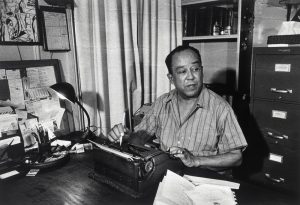
Langston Hughes Wikipedia
| Category | Details |
|---|---|
| Full Name | James Mercer Langston Hughes |
| Date of Birth | February 1, 1902 (sometimes reported as 1901) |
| Place of Birth | Joplin, Missouri, United States |
| Date of Death | May 22, 1967 |
| Place of Death | New York City, New York, U.S. |
| Cause of Death | Prostate cancer |
| Age at Death | 65 years |
| Nationality | American |
| Occupations | Poet, Novelist, Playwright, Columnist, Essayist |
| Known For | Leading voice in the Harlem Renaissance, jazz poetry |
| Movement | Harlem Renaissance |
| Major Themes | Racial identity, pride, dreams deferred, social justice, Black culture |
| Education | Columbia University (attended, 1920), Lincoln University (B.A., 1929) |
| First Published Poem | The Negro Speaks of Rivers (1921) |
| First Poetry Collection | The Weary Blues (1926) |
| Notable Works | Not Without Laughter (1930), Montage of a Dream Deferred (1951) |
| Famous Poem | Harlem (“What happens to a dream deferred?”) |
| Famous Character | Jesse B. Semple (“Simple”) |
| Genres | Poetry, Fiction, Drama, Children’s Literature, Essays |
| Autobiographies | The Big Sea (1940), I Wonder as I Wander (1956) |
| Travel Experience | Mexico, West Africa, Europe, Soviet Union |
| Marital Status | Never married |
| Children | None |
| Sexual Orientation | Never publicly disclosed (subject of scholarly speculation) |
| Residence | Harlem, New York City |
| Burial Place | Schomburg Center for Research in Black Culture, Harlem, NYC |
| Legacy Title | “Poet Laureate of Harlem” |
| Posthumous Honors | Langston Hughes Medal, U.S. Stamp (2002), schools/libraries named after him |
| Net Worth at Death | Estimated under $50,000 (≈ $450,000–$500,000 today) |
| Impact on Literature | Influenced generations of African-American and global writers |
| Signature Style | Jazz-influenced, accessible, culturally rich poetry |
| Quick Quote | “What happens to a dream deferred?” |
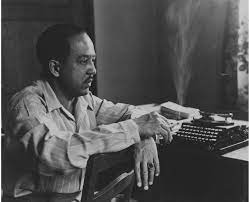
Langston Hughes’ Early Life & Education
Langston Hughes was born on February 1, 1902, in Joplin, Missouri, to James Nathaniel Hughes and Carrie Langston Hughes. Shortly after his birth, his parents separated, and his father moved to Mexico.
As a result, Hughes was primarily raised by his grandmother, Mary Patterson Langston, in Lawrence, Kansas.
His grandmother’s stories of racial pride and resilience deeply influenced his early worldview and later writings.
After his grandmother’s death, Hughes lived with family friends and later with his mother in various cities, including Lincoln, Illinois, and Cleveland, Ohio, where he attended high school.
It was during this time that he began writing poetry seriously, publishing his first poems in his school magazine and developing his lifelong passion for literature.
In 1920, Hughes enrolled at Columbia University in New York City to study engineering at his father’s insistence.
However, he left after a year due to racial discrimination and a growing dissatisfaction with the rigid academic environment.
Hughes later pursued his literary ambitions and eventually enrolled at Lincoln University, a historically Black college in Pennsylvania, where he earned his Bachelor of Arts degree in 1929.
Hughes’s early life and educational journey, marked by frequent moves, family hardship, and encounters with racism, played a foundational role in shaping his literary voice, one that would speak powerfully and authentically for generations of African Americans.
Check Out: Randy Jackson Biography, Early Life, American Idol, Personal Life, Weight Loss, Net Worth, Instagram
Langston Hughes: The Harlem Renaissance and Literary Career
Langston Hughes emerged as one of the most influential figures of the Harlem Renaissance, a cultural, artistic, and intellectual explosion centered in Harlem, New York, during the 1920s and 1930s.
This movement celebrated African American cultural identity, creativity, and expression, and Hughes stood at its heart as a literary pioneer who gave a powerful voice to the Black experience.
Hughes moved to Harlem in the early 1920s and quickly became a central figure in the movement.
Unlike many writers of his time, he insisted on portraying real-life Black experiences, not idealized or conformed to white expectations.
He embraced Black vernacular, jazz, blues, spirituals, and folklore, incorporating them into his writing to reflect the rhythms and soul of Black life.
His first major work, The Negro Speaks of Rivers, published in 1921, set the tone for his literary mission: connecting the African-American experience to a broader, historical, and spiritual context.
In 1926, he published The Weary Blues, his first poetry collection, which earned critical acclaim for its innovative use of jazz rhythms and its authentic voice.
Throughout the Harlem Renaissance and beyond, Hughes published a wide variety of works:
Poetry collections: Fine Clothes to the Jew (1927), Montage of a Dream Deferred (1951)
Novels: Not Without Laughter (1930), Tambourines to Glory (1958)
Short stories: The Ways of White Folks (1934)
Plays: Mulatto (1935), Troubled Island (1949, with composer William Grant Still)
Children’s books, autobiographies (The Big Sea, 1940), and newspaper columns
In the 1940s, he introduced the humorous and insightful character Jesse B. Semple (nicknamed “Simple”) in his newspaper columns.
Through Simple’s voice, Hughes offered commentary on race, politics, and everyday life in Harlem, making him a beloved figure among readers.
Hughes’s writing style was straightforward, lyrical, and musical, often inspired by jazz and blues, which he called the “true voice of the Negro people.”
He believed literature should be accessible and reflect the lives, language, and struggles of ordinary Black Americans.
Hughes’s involvement in the Harlem Renaissance not only helped elevate Black culture in the American consciousness but also shaped a new literary tradition.
His fearless exploration of race, inequality, heritage, and hope solidified his role as the “Poet Laureate of Harlem” and a defining voice of 20th-century American literature.
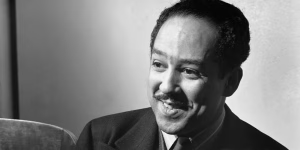
Langston Hughes Key Themes and Contributions
Langston Hughes’s work is defined by a rich tapestry of themes that reflect the complexity, resilience, and beauty of the African-American experience.
His contributions to literature, culture, and social consciousness remain timeless and deeply impactful.
Key Themes in Hughes’s Work:
1. Racial Identity and Pride: Hughes celebrated Black heritage, culture, and strength. He wrote unapologetically about being African-American, empowering readers to embrace their identity with pride and dignity.
2. The “Dream Deferred”: One of his most famous and recurring themes, particularly in the poem Harlem (1951), is the idea of unfulfilled dreams due to racial and economic injustice:
“What happens to a dream deferred?”
This theme symbolizes the frustrations of Black Americans striving for equality in a system that continually denied them opportunity.
3. Struggle and Resilience: Hughes portrayed the daily hardships of African Americans, poverty, racism, and segregation, but also emphasized their strength, hope, and perseverance.
4. Music – Jazz and Blues Influence: He infused his poetry with the rhythm and emotion of jazz, blues, and spirituals, capturing the soul of Black America. This musical influence became a signature feature of his style.
5. Social Justice and Equality: Hughes utilized his platform to speak out against oppression and advocate for civil rights. His works championed freedom, fairness, and justice across racial and social divides.
6. Community and Common People: He often centered his stories and poems on working-class Black individuals, showing their humanity, humor, and everyday experiences, especially through characters like Jesse B. Semple (“Simple”).
7. African Heritage and Diaspora: In poems like The Negro Speaks of Rivers, Hughes connected the African-American experience to ancient African civilizations, promoting a sense of historical continuity and pride.
Major Contributions:
1. Harlem Renaissance Leadership: Hughes was a literary cornerstone of the Harlem Renaissance, shaping its voice and philosophy.
2. Pioneering Jazz Poetry: He created a new form of expression by blending jazz and blues with verse, known as jazz poetry.
3. Representation of Black Life: He was among the first to portray African-American life honestly and fully, without catering to white audiences.
4. Multi-Genre Mastery: Hughes wrote across genres, poetry, plays, novels, short stories, children’s books, autobiographies, and newspaper columns, showing exceptional versatility.
5. Literary Inspiration: He paved the way for future Black writers like Maya Angelou, Amiri Baraka, James Baldwin, and Nikki Giovanni.
6. Cultural Icon: Known as the “Poet Laureate of Harlem,” Hughes became a symbol of Black artistic expression and social advocacy.
Langston Hughes’s legacy lies in his unwavering commitment to capturing Black reality with beauty, truth, and soul, making him not only a key literary figure but also a cultural hero whose influence spans generations.
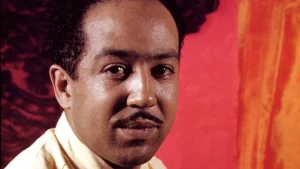
Langston Hughes’ Death and Honors
Langston Hughes passed away on May 22, 1967, at the age of 65, from complications related to prostate cancer.
He died at Polyclinic Hospital in New York City, leaving behind a profound legacy as one of the most influential literary figures in American history.
Though he had no children, his “offspring” were the countless writers, artists, and thinkers inspired by his voice, vision, and activism.
After his death, Hughes’s ashes were interred beneath the floor of the Schomburg Center for Research in Black Culture in Harlem.
A beautiful black granite medallion marks the spot, inscribed with a line from his most iconic poem, The Negro Speaks of Rivers:
“My soul has grown deep like the rivers.”
Langston Hughes Honors and Posthumous Recognition
Langston Hughes received many honors during and after his lifetime, recognizing his literary excellence, cultural impact, and contribution to civil rights:
Langston Hughes Medal (established in 1978 by the City College of New York) – awarded annually to outstanding African-American writers.
Schools and libraries across the United States have been named after him.
U.S. Postal Service honored him with a commemorative postage stamp in 2002 as part of the Black Heritage series.
Inducted into the National Institute of Arts and Letters and other literary institutions.
His former residence at 20 East 127th Street, Harlem, was declared a New York City Landmark.
He is honored in the American Poets’ Corner at the Cathedral of St. John the Divine in New York.
His works are part of academic curricula worldwide, studied as central to African-American literature and American poetry.
Langston Hughes’s death marked the end of a literary era, but his words continue to live, resonate, and inspire, ensuring that his legacy remains deeply rooted in the cultural fabric of America and beyond.
Langston Hughes’ Personal Life
Discover more from Labaran Yau
Subscribe to get the latest posts sent to your email.
